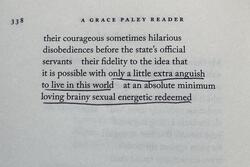From Tekhines to Tap Dance
Ever seen women with headscarves doing Vaudeville? Last week's Forward featured an article about Atara, an association of Torah observant artists whose new mission is to bring Orthodox female artists and performers together to nurture their creative expression -- be it through theatre, music, art, spoken word, etc. -- within a halachic framework.
It strikes me as a much needed initiative and something that could be especially empowering for Orthodox women whose circumstances in secular environments (and in male-dominant religious environments) do not often allow for artistic performance opportunities. I suspect that Sophie Tucker (featured in JWA's new documentary Making Trouble), who, in the late 1800s, was ostracized by her Orthodox community when she set out to be an entertainer, would be proud to know that now there are opportunities in which Halachic observance and artistic expression can intersect.
I'm impressed by this initiative (doubly impressed that someone I know is featured as a co-organizer of a recent Atara women's production at Stern College) and by the first annual Torah & Arts conference with workshops in playwriting, songwriting, choreography, vocal coaching, dancing and acting.
But two things strike me as challenging. The first is that the majority of women active in Atara are ba'alot teshuvah, women who only became very religious later in life and had to check their "secular" talents at the door. Only now are they re-embracing their call to perform. But what about the women who grew up Orthodox? Where are they in this picture? Will this initiative give them the opportunity to develop their artistic skills? The other thing that strikes me is the mention of Robin Garbose, Hollywood's only Orthodox female filmmaker who completed a film under rabbinic supervision that is "intended for the eyes of women and girls only." Within a halachic framework, it's to be expected that opportunities for self-expression exist only within a fixed set of parameters. But can there be performance opportunities that really honor the authenticity of female performers if, ultimately, decisions must be channeled through and approved by a male rabbi?







Interesting post -- but how much other media must be hechshered, male or female-made? (I'm thinking of 'Ushpizin' and the more stringent Yiddish action film 'A Gesheft,' made in Monsey with no women depicted). See also this article about a Japanese convert and former dancer who now has a solid career appearing for female, frum audiences in Jerusalem and elsewhere:
http://www.nytimes.com/2005/02...